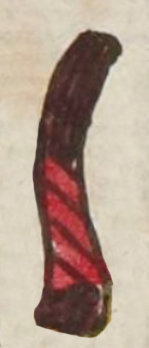tzontli (TR21r)
This iconographic example of a priestly ponytail or bound lock of hair, the tzontli, has been carved from a blood-letting scene as shown in the contextualizing image. Here, as seen in some glyphs, the priest's hair is wrapped tightly with a red tie, perhaps a leather thong or a cord (the latter being a red hair tie called tochacatl). The ponytail of dark brown or black hair is standing upright.
Stephanie Wood
The tzontli can vary greatly in the Codex Mendoza and other codices from this type of ponytail (or hank of hair) to something that looks like a tree, a feather, or a group of blades of grass (see below). In Spanish, a similar red leather tie is called a "cinta de cuero rojo," employed in the process of tying up one's hair to be converted into a warrior, according to Guy Stresser-Péan (1995, 45). (See our Bibliography for the full citation to his study.) When worn by a warrior, this hairstyle could also be called the temilotli.
Stephanie Wood
ca. 1550–1563
Jeff Haskett-Wood

tzon(tli), hair, https://nahuatl.wired-humanities.org/content/tzontli
temilo(tli), a warrior hairstyle, https://nahuatl.wired-humanities.org/content/temilotli
tlatzonilpia, to tie up the hair, https://nahuatl.wired-humanities.org/content/tlatzonilpia
pelo atado con una cinta de cuero rojo
Stephanie Wood
Telleriano-Remensis Codex, folio 21 recto, MS Mexicain 385, Gallica digital collection, https://gallica.bnf.fr/ark:/12148/btv1b8458267s/f67.item.zoom
The non-commercial reuse of images from the Bibliothèque nationale de France is free as long as the user is in compliance with the legislation in force and provides the citation: “Source gallica.bnf.fr / Bibliothèque nationale de France” or “Source gallica.bnf.fr / BnF.”







